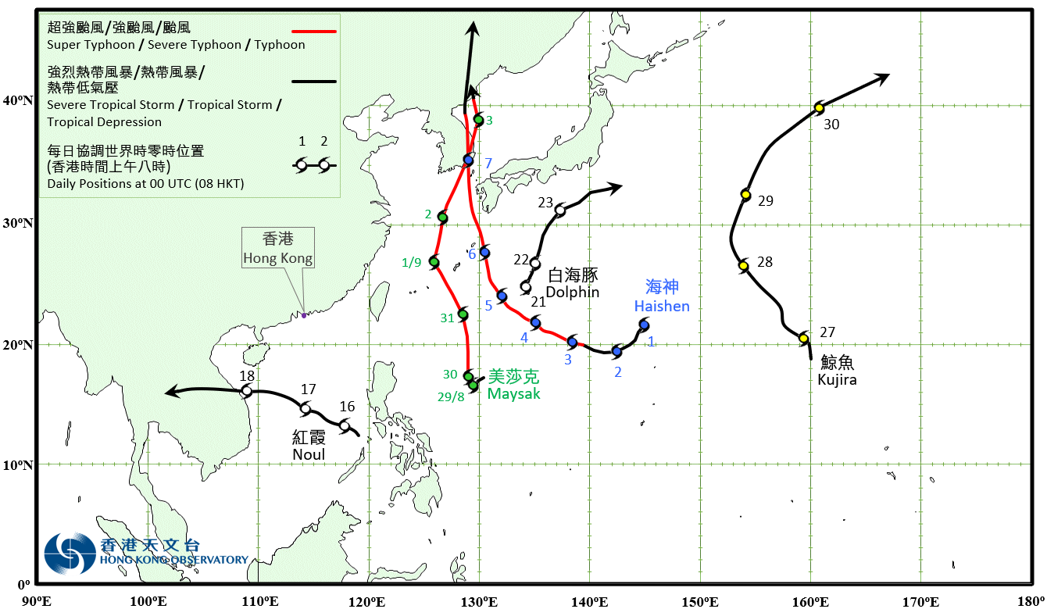Overview of Tropical Cyclones in September 2020
|
Five tropical cyclones occurred over the western North Pacific and the South China Sea in September 2020. Maysak formed as a tropical depression over the western North Pacific about 1050 km east-northeast of Manila on the afternoon of 28 August. It lingered around the sea areas east of the Philippines and intensified in the following two days. Maysak developed into a typhoon in the small hours of 30 August and accelerated northward. It further intensified into a super typhoon on the night of 31 August and tracked north-northwestward towards the vicinity of Ryukyu Islands. Maysak reached its peak intensity on the morning of 1 September with an estimated sustained wind of 195 km/h near its centre. Maysak then turned to move north-northeastward and swept across the East China Sea and the Korean Peninsula. It finally evolved into an extratropical cyclone on the afternoon of 3 September over the northeastern part of the Korean Peninsula. According to press reports, at least 26 people were injured in Japan during the passage of Maysak. A cargo ship sank near Amami Oshima of the Kagoshima Prefecture with at least 42 people on board missing. Besides, at least two persons were killed and 12 people were injured when Maysak moved across the Korean Peninsula. Haishen formed as a tropical depression over the western North Pacific about 510 km southeast of Iwo Jima on the morning of 1 September. It moved southwestward and intensified gradually on that day. Haishen turned to track west-northwestward across the western North Pacific on 2 September and developed into a typhoon on the early morning of 3 September. Haishen further intensified into a super typhoon on 4 September and reached its peak intensity with an estimated maximum sustained wind of 220 km/h near its centre. Turning to track north-northwestward gradually, Haishen swept across the seas west of Kyushu and then the Korean Peninsula and weakened gradually. Haishen finally evolved into an extratropical cyclone over the northeastern part of China on the early morning of 8 September. According to press reports, Haishen left at least two deaths, four missing and 100 injuries in Japan during its passage. Haishen was the second storm hitting the Korean Peninsula within a week after Maysak, causing at least two deaths and wide-spread flooding. Many houses were damaged. Noul formed as a tropical depression over the southern part of the South China Sea about 880 km east-southeast of Xisha on the night of 15 September. It moved west-northwestward and intensified gradually. Noul developed into a tropical storm on the morning of 16 September. It further intensified into a severe tropical storm the next day and reached its peak intensity with an estimated maximum sustained wind of 90 km/h near its centre. Noul moved across the central part of Vietnam on 18 September and weakened. It finally degenerated into an area of low pressure over the Indochina Peninsula on the early morning of the next day. According to press reports, at least six people were killed in Vietnam during the passage of Noul. Dolphin formed as a tropical depression over the western North Pacific about 1160 km south of Osaka on the small hours of 21 September. It tracked north-northeastward slowly and intensified gradually. Dolphin developed into a severe tropical storm the next day and reached its peak intensity that night with an estimated maximum sustained wind of 105 km/h near its centre. Dolphin then turned to move east-northeastward and finally evolved into an extratropical cyclone over the seas east of Japan on 24 September. Kujira formed over the western North Pacific about 2040 km east-southeast of Iwo Jima on the night of 26 September. It moved generally northwestward and intensified gradually. Kujira intensified into a severe tropical storm on the night of 28 September and reached its peak intensity in the next morning with an estimated maximum sustained wind of 110 km/h near its centre. Kujira then gradually turned to track northeastward and finally evolved into an extratropical cyclone over the western North Pacific east of Japan on 30 September. |

Provisional Tropical Cyclone Tracks in September 2020